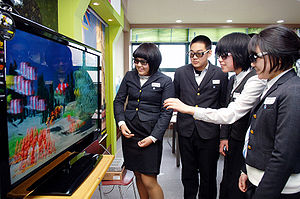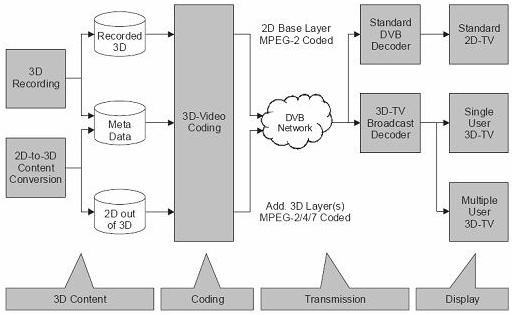3DTV
التلفاز ذى الأبعاد الثلاثة هو التلفاز الذي يستخدم تقنيات العرض للفيلم الثلاثى الأبعاد ، مثل اللقطات الاستريوسكوبية و اللقطات بطريقة العرض المتعددة أو البعدين زائد العمق و العروض المجسمة وهى أداة لعرض المشروع على برنامج تلفازى ذى ثلاثة أبعاد واقعية ميدانية .أما حلقات العروض المجسمة فقد أصبحت شائعة في أواخر التسعينات عندما ظهر العديد منها في الولايات المتحدة و أستخدمت هذه التقنية لجذب المشاهدين ، وزيادة التقييم.

التاريخ
Please help improve this article or section by expanding it. Further information might be found on the talk page or at requests for expansion. (February 2010) |
العروض للصور المجسمة تعود إلى بداية التصوير الفوتوغرافي. في عام 1844 ، قدم ديفيد بروستر المجسام ، وهو الجهاز الذي يمكنه التقاط الصور الفوتوغرافية المجسمة. كان في ذلك الحين و قد تم تحسينه من قبل لويس جول Duboscq و كانت صورته الشهيرة للملكة فيكتوريا التى تم عرضها في المعرض العظيم في عام 1851. وبحلول الحرب العالمية الثانية فقد أصبحت الكاميرا المجسمة ذات (3D) بالفعل شائعة إلى حد كبير للاستعمال الشخصي .
تطوير الأفلام المجسمة كان موازيا لتلك التي للصور والخيالات المجسمة . وبالفعل في عام 1855 فقد أخترع Kinematoscope ، أي حركة الكاميرا بطريقة ستيريو أى (مجسم). الصورة الأولى فيلم النقش أنتج عام 1915 وعام 1922 في أول العام تم عرض فيلم مجسم قوة الحب . في عام 1935 تم إنتاج أول فيلم مجسم ملون.
في الخمسينات ، عندما أصبحت للتلفاز شعبية في الولايات المتحدة ،فإن العديد من الأفلام قد أنتجت بالأسلوب المجسم. وأول فيلم من هذا القبيل هو Bwana الشيطان من يونايتد آرتستس UA التي يمكن أن ينظر في جميع أنحاء الولايات المتحدة في عام 1952. ,وبعد سنة واحدة في وقت لاحق ، في عام 1953 ، وجاء فيلم ثلاثى الأبعاد أيضا منزل الشمع(فيلم 1953 ) الذي ظهر أيضا بالصوت المجسم . ألفريد هيتشكوك في الأصل جعل فيلمه أدر الرقم م للقتل بالأبعاد الثلاثة ، ولكن لغرض تحقيق أقصى قدر من الأرباح من الفيلم قد أطلق بالبعدين فقط لأنه ليست جميع دور السينما كانت قادرة على عرض الأفلام بالأبعاد الثلاثة. الاتحاد السوفياتي أنتج أفلاما مجسمة كما في فيلم روبنسون كروزو الذى عرض لأول مرة في عام 1947[بحاجة لمصدر]
بعد ذلك ، بدأت محطات التلفزة ببث المسلسلات الثلاثية الأبعاد استنادا إلى نفس التكنولوجيا الأفلام الثلاثية الأبعاد..[بحاجة لمصدر]
التقنيات
هناك العديد من التقنيات لإنتاج وعرض صورا متحركة ذات ثلاثة أبعاد.
التكنولوجيا الشائعة للعروض المجسمة من أجل إبراز صورة مجسمة مزدوجة يراها المشاهد هى كما يلي :
- Anaglyphic ثلاثية الأبعاد (مع النظارات الأحمر السلبي السماوي )
- (موجات) الاستقطاب ثلاثية الأبعاد (مع النظارات سلبية الاستقطاب )
- الإطار التسلسلى الإستبدالى (مع النظارات النشطة المصراعية/ مثبتة بالرأس)
- العروض المجسمة الآلية يعرض (بدون نظارات / مثبتة بالرأس)
المشروع ذى العرض الواحد تعرض فقط الزوج من اللقطات المجسمة ستيريو في وقت واحد. العرض على شاشات متعددة إما عرض رئيسى لإستخدام نظام التتبع لتغيير وجهة النظر تبعا لزاوية المشاهدة ، أو مشاريع متعددة في وقت واحد وجهات نظر مستقلة من مشهد للمشاهدين متعددة (automultiscopic) هذه المشاهد المتعددة يمكن أن تنتج باستخدام أسلوب on-the-fly تقنية صورة ذات بعدين زائد عمق .
مختلف تقنيات العرض الأخرى قد فصلت ، مثل الهولوجرافى ، العروض الحجمية و تأثير بولفريك ، التي كانت تستخدم من قبل Doctor Who ل الأبعاد في الزمن في عام 1993 ، من قبل الروك الثالث من الشمس في عام 1997 ، و من قبل قناة ديسكفري ' أسبوع القرش في عام 2000 ، من بين آخرين. التلفزيون ثلاثى الأبعاد في الوقت الحقيقى (فيديو يوتيوب)] هو في جوهره شكل من أشكال العرض الآلى ذى الأبعاد الثلاثة. http://www.youtube.com/watch?v=Dvn1e343Clo Youtube video
Stereoscopy is most widely accepted method for capturing and delivering 3D video. It involves capturing stereo pairs in a two-view setup, with cameras mounted side by side, separated by the same distance as between a person's pupils. If we imagine projecting an object point in a scene along the line-of-sight (for each eye, in turn) to a flat background screen, we may describe the location of this point mathematically using simple algebra. In rectangular coordinates with the screen lying in the Y-Z plane (the Z axis upward and the Y axis to the right) and the viewer centered along the X axis, we find that the screen coordinates are simply the sum of two terms, one accounting for perspective and the other for binocular shift. Perspective modifies the Z and Y coordinates of the object point by a factor of D/(D-x), while binocular shift contributes an additional term (to the Y coordinate only) of s*x/(2*(D-x)), where D is the distance from the selected system origin to the viewer (right between the eyes), s is the eye separation (about 7 centimeters), and x is the true x coordinate of the object point. The binocular shift is positive for the left-eye-view and negative for the right-eye-view. For very distant object points, it is obvious that the eyes will be looking along the same line of sight. For very near objects, the eyes may become excessively "cross-eyed". However, for scenes in the greater portion of the field of view, a realistic image is readily achieved by superposition of the left and right images (using the polarization method or synchronized shutter-lens method) provided the viewer isn't too near the screen and the left and right images are correctly positioned on the screen. Digital technology has largely eliminated inaccurate superposition that was a common problem during the era of traditional stereoscopic films.[1] [2]
Multi-view capture uses arrays of many cameras to capture a 3D scene through multiple independent video streams. Plenoptic cameras, which capture the light field of a scene, can also be used to capture multiple views with a single main lens.[3] Depending on the camera setup, the resulting views can either be displayed on multi-view displays, or passed for further image processing.
After capture, stereo or multi-view image data can be processed to extract 2D plus depth information for each view, effectively creating a device-independent representation of the original 3D scene. This data can be used to aid inter-view image compression or to generate stereoscopic pairs for multiple different view angles and screen sizes.
2D plus depth processing can be used to recreate 3D scenes even from a single view and convert legacy film and video material to a 3D look, though a convincing effect is harder to achieve and the resulting image will likely look like a cardboard miniature.
أجهزة التلفاز الجاهزة للعرض الثلاثى الأبعاد
جهود وضع المقاييس
البث
القنوات الثلاثية الأبعاد
الحلقات الثلاثية الأبعاد
أنظر ايضا
المراجع
- ^ name = Donald Allan Mitchell, original unpublished work.
- ^ Kenneth Wittlief (2007-07-30). "Stereoscopic 3D Film and Animation - Getting It Right". ACM SIGGRAPH. Retrieved 2009-03-30.
- ^ http://ieeexplore.ieee.org/xpl/freeabs_all.jsp?arnumber=4547873 A Simulator for the Cafadis Real Time 3DTV Camera, IEEE (2008-06-20)
- Articles to be expanded since February 2010
- All articles to be expanded
- Articles with unsourced statements from May 2009
- Articles with unsourced statements from January 2010
- Articles with hatnote templates targeting a nonexistent page
- 3D computer graphics
- 3D imaging
- Television specials
- Visual effects
- Television technology
